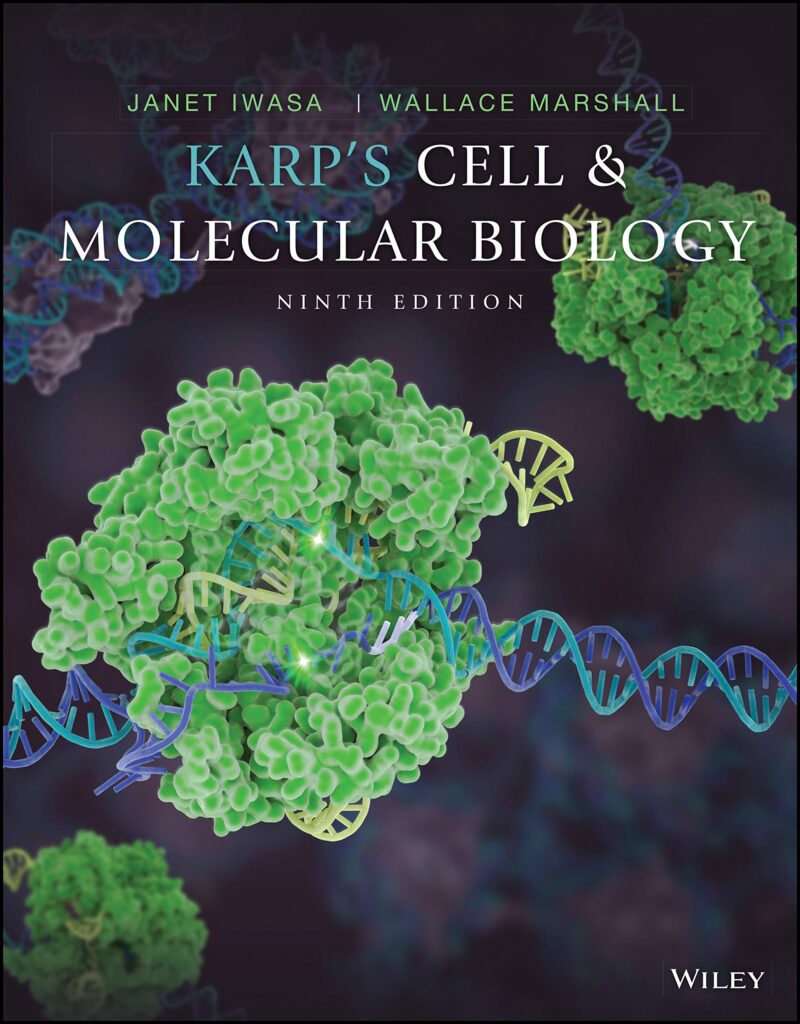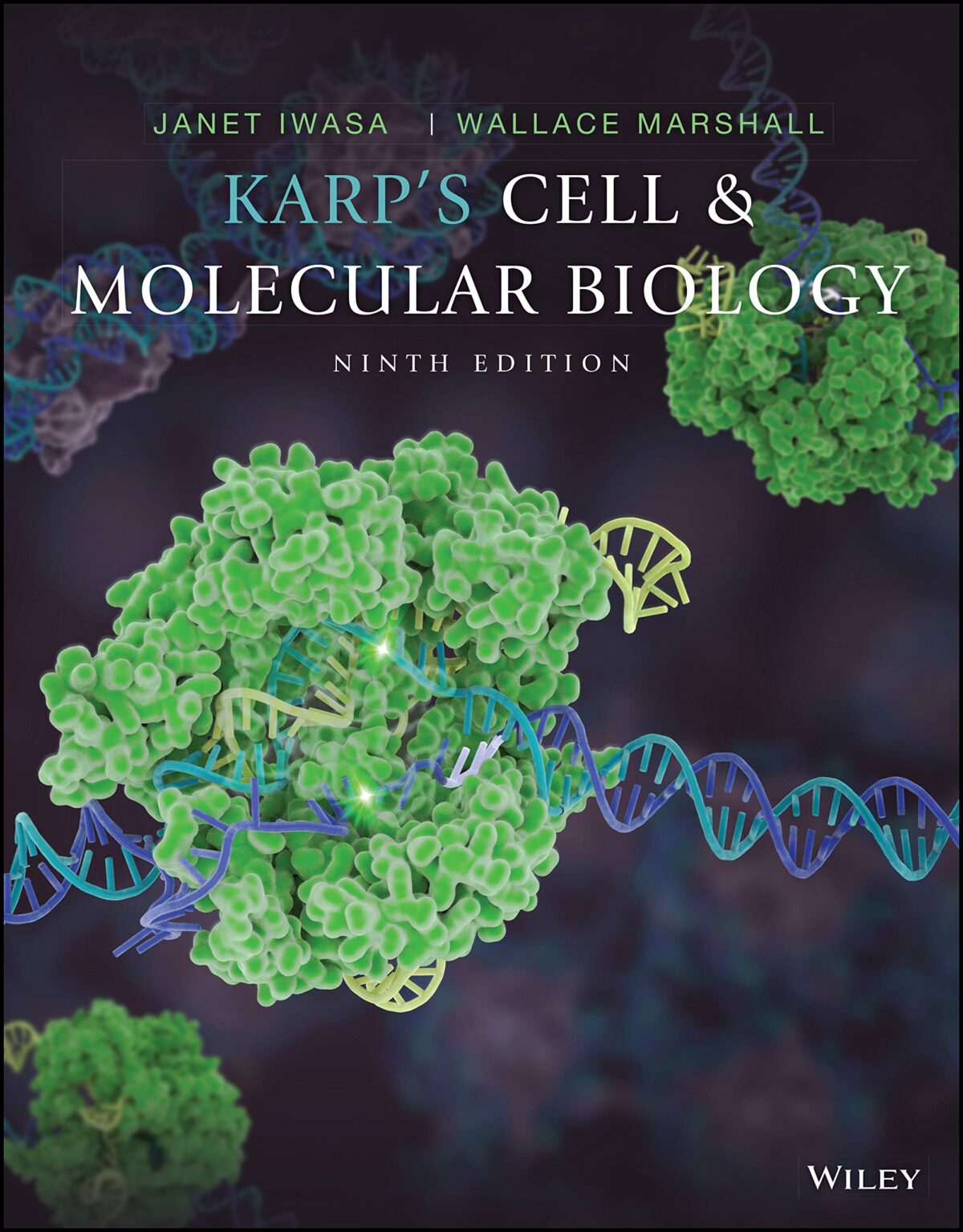Would you like to get Karp’s cell and molecular biology 9th edition pdf Download? Are you studying cell and molecular biology and do you need a good book to learn all the basic concepts you need to excel? Karp’s cell and molecular biology book pdf is all you need. Karp’s cell and molecular biology book is a very popular book among students and that’s why we have made it available for fast free and easy accessibility.
The Cell and Molecular Biology Karp 9th Edition Offers a proper balance of theories and experimentation. Experimental detail is offered when it helps to buttress the concept being explained. In The Cell and Molecular Biology Karp 9th Edition pdf book, Illustrations are paired with micrographs to help students compare the real (micrograph) with the ideal (illustration). So, if you would like to learn all the basic concepts you need to excel in Cell and Molecular Biology then this is just the right book for you!
Table of Contents
Karp’s Cell and Molecular Biology 9th Edition PDF Free Download Details
- Book Title: Karp’s Cell and Molecular Biology PDF
- Edition: 9th
- Previous Edition: Karp’s Cell and Molecular Biology 9th Edition PDF
- Author: Gerald Karp, Janet Iwasa, Wallace Marshall
- Published: December 2019
- ISBN: 9781119598169
- Goodreads Link: Karp’s Cell and Molecular Biology, 9th Edition by Gerald Karp PDF
- Formats: PDF
- No. of pages: 944 pages
- Size: MB
- Genre: TextBook
- Language: English
- File Status: Available
- Price: $0
About The Cell and Molecular Biology Karp 9th Edition PDF eBook
Karp’s Cell and Molecular Biology 9th Edition PDF connect key concepts and experimentation, so they better understand how we know what we know in the world of cell biology.
This classic text explores core concepts in considerable depth, often adding experimental detail. It is written in an inviting style and at mid-length, to assist students in managing the plethora of details encountered in the Cell Biology course.
The 9th Edition includes two new sections and associated assessments in each chapter that show the relevance of key cell biology concepts to plant cell biology and bioengineering.
NEW TO Karp’s Cell and Molecular Biology 9th Edition PDF
A complete reworking of the previous edition, Karp’s Cell and Molecular Biology, 9e delivers a concise and illustrative narrative that helps students connect key concepts and experimentation in order that they better understand how we know what we know in the world of cell biology.
Two new sections and associated assessments in each chapter show the relevance of key cell biology concepts to plant cell biology and bioengineering. These new sections, together with updated and restructured core content, new digital tools, and a new WileyPLUS experience, give faculty members the freedom and flexibility to use Karp’s Cell and Molecular Biology for a variety of different biology courses.
- New section and assessment in each chapter covering Plant Cell Biology
- New section and assessment in each chapter covering Bioengineering
- New WileyPLUS course for the first time
- Adaptive Practice for the first time
- New interactive graphics
Karp’s Cell and Molecular Biology 9th Edition FEATURES:
Human Perspective, Experimental Pathways, Plant Cell Biology (new), and Bioengineering (new) features intertwine with the text, providing à la carte options for faculty whose focus might be on one or more cell biology sub-disciplines.
Karp is written in an inviting style and at mid-length, to assist students in managing the plethora of details encountered in the Cell Biology course.
Table of contents For Cell and Molecular Biology Karp 9th Edition PDF
1 Introduction to the Study of Cell and Molecular Biology 1
1.1 The Discovery of Cells 2
1.2 Basic Properties of Cells 3
1.3 Two Fundamentally Different Classes of Cells 8
1.4 Viruses and Viroids 26
1.5 Green Cells: Volvox, an Experiment in Multicellularity 35
1.6 Engineering Linkage: Tissue Engineering 36
2 The Chemical Basis of Life 39
2.1 Covalent Bonds 40
2.2 Engineering Linkage: Radionuclides for Imaging and Treatment 43
2.3 Noncovalent Bonds 44
2.4 Acids, Bases, and Buffers 48
2.5 The Nature of Biological Molecules 49
2.6 Green Cells: Chemical Fertilizers 52
2.7 Four Types of Biological Molecules 53
2.8 The Formation of Complex Macromolecular Structures 95
3 Bioenergetics, Enzymes, and Metabolism 99
3.1 Bioenergetics 100
3.2 Enzymes as Biological Catalysts 108
3.3 Metabolism 123
3.4 Green Cells: Regulation of Metabolism by the Light/Dark Cycle 134
3.5 Engineering Linkage: Using Metabolism to Image Tumors 135
4 The Structure and Function of the Plasma Membrane 137
4.1 Introduction to the Plasma Membrane 138
4.2 The Chemical Composition of Membranes 142
4.3 Membrane Proteins 148
4.4 Membrane Lipids and Membrane Fluidity 156
4.5 The Dynamic Nature of the Plasma Membrane 159
4.6 The Movement of Substances across Cell Membranes 166
4.7 Membrane Potentials and Nerve Impulses 189
4.8 Green Cells: Electrical Signaling in Plants 198
4.9 Engineering Linkage: Neurotechnology 199
5 Aerobic Respiration and the Mitochondrion 203
5.1 Mitochondrial Structure and Function 204
5.2 Aerobic Metabolism in the Mitochondrion 209
5.3 The Role of Mitochondria in the Formation of ATP 215
5.4 Engineering Linkage: Measuring Blood Oxygen 224
5.5 Establishment of a Proton-Motive Force 225
5.6 The Machinery for ATP Formation 226
5.7 Peroxisomes 233
5.8 Green Cells: Glyoxysomes 237
6 Photosynthesis and the Chloroplast 239
6.1 The Origin of Photosynthesis 240
6.2 Chloroplast Structure 241
6.3 An Overview of Photosynthetic Metabolism 243
6.4 The Absorption of Light 244
6.5 Green Cells: Chromoplasts 246
6.6 Photosynthetic Units and Reaction Centers 247
6.7 Photophosphorylation 255
6.8 Carbon Dioxide Fixation and the Synthesis of Carbohydrate 256
6.9 Engineering Linkage: Photodynamic Therapy 264
7 Interactions Between Cells and Their Environment 267
7.1 Extracellular Interactions 268
7.2 Engineering Linkage: Organoids 277
7.3 Interactions of Cells with Extracellular Materials 278
7.4 Interactions of Cells with Other Cells 284
7.5 Tight Junctions: Sealing the Extracellular Space 294
7.6 Intercellular Communication 296
7.7 Cell Walls 303
7.8 Green Cells: Cell Walls and Plant Terrestrialization 306
8 Cytoplasmic Membrane Systems: Structure, Function, and Membrane Trafficking 307
8.1 An Overview of the Endomembrane System 308
8.2 A Few Approaches to the Study of Endomembranes 311
8.3 The Endoplasmic Reticulum 317
8.4 The Golgi Complex 330
8.5 Types of Vesicle Transport 335
8.6 Engineering Linkage: Extracellular Vesicles for Drug Delivery 347
8.7 Lysosomes 348
8.8 Green Cells: Plant Cell Vacuoles 350
8.9 The Endocytic Pathway: Moving Membrane and Materials into the Cell Interior 351
8.10 Posttranslational Uptake of Proteins by Peroxisomes, Mitochondria, and Chloroplasts 363
9 The Cytoskeleton and Cell Motility 369
9.1 Overview of the Major Functions of the Cytoskeleton 370
9.2 Structure and Function of Microtubules 372
9.3 Green Cells: Why the Woodbine Twineth 376
9.4 Motor Proteins: Kinesins and Dyneins 377
9.5 Microtubule-Organizing Centers (MTOCs) 383
9.6 Structure and Function of Cilia and Flagella 390
9.7 Intermediate Filaments 398
9.8 Actin and Myosin 402
9.9 Muscle Organization and Contraction 410
9.10 Engineering Linkage: Muscle Biomechanics 416
9.11 Actin-Binding Proteins 417
9.12 Cellular Motility 420
9.13 The Bacterial Cytoskeleton 430
10 The Nature of the Gene and the Genome 433
10.1 The Concept of a Gene as a Unit of Inheritance 434
10.2 The Discovery of Chromosomes 435
10.3 Chromosomes as the Carriers of Genetic Information 436
10.4 The Chemical Nature of the Gene 441
10.5 The Complexity of the Genome 452
10.6 The Stability of the Genome 458
10.7 Sequencing Genomes: The Footprints of Biological Evolution 464
10.8 Engineering Linkage: Engineering Genomes 467
10.9 The Genetic Basis of “Being Human” 468
10.10 Green Cells: Gene Transfer by Agrobacterium tumefaciens 475
11 The Central Dogma: DNA to RNA to Protein 477
11.1 The Relationships among Genes, Proteins, and RNAs 478
11.2 An Overview of Transcription in Both Prokaryotic and Eukaryotic Cells 483
11.3 Synthesis and Processing of Eukaryotic Ribosomal and Transfer RNAs 487
11.4 Synthesis and Structure of Eukaryotic Messenger RNAs 491
11.5 Small Regulatory RNAs and RNA Silencing Pathways 507
11.6 Green Cells: Long-Range siRNA Movement 512
11.7 CRISPR and Other Noncoding RNAs 513
11.8 Encoding Genetic Information 514
11.9 Decoding the Codons: The Role of Transfer RNAs 517
11.10 Translating Genetic Information 520
11.11 Engineering Linkage: DNA Origami 534
12 Control of Gene Expression 537
12.1 Control of Gene Expression in Bacteria 538
12.2 Engineering Linkage: Building Digital Logic with Genes 542
12.3 Structure of the Nuclear Envelope 543
12.4 Chromosomes and Chromatin 550
12.5 The Nucleus as an Organized Organelle 567
12.6 An Overview of Gene Regulation in Eukaryotes 570
12.7 Transcriptional Control 571
12.8 Green Cells: The ABC Model and MADS Domain Transcription Factors 592
12.9 RNA Processing Control 593
12.10 Translational Control 594
12.11 Posttranslational Control: Determining Protein Stability 601
13 DNA Replication and Repair 605
13.1 DNA Replication 606
13.2 DNA Replication in Bacterial Cells 610
13.3 The Structure and Functions of DNA Polymerases 617
13.4 Replication in Viruses 621
13.5 Engineering Linkage: Storing Data in DNA 621
13.6 DNA Replication in Eukaryotic Cells 622
13.7 DNA Repair 628
13.8 Green Cells: Gamma Gardens 632
13.9 Between Replication and Repair 633
14 Cell Division 637
14.1 The Cell Cycle 638
14.2 M Phase: Mitosis and Cytokinesis 651
14.3 Engineering Linkage: The Role of Membrane Tension in Cell Division 672
14.4 Green Cells: Unique Aspects of Plant Cell Division 673
14.5 Meiosis 673
15 Cell Signaling and Signal Transduction: Communication between Cells 685
15.1 The Basic Elements of Cell Signaling Systems 686
15.2 A Survey of Extracellular Messengers and Their Receptors 689
15.3 G Protein-Coupled Receptors and Their Second Messengers 690
15.4 Engineering Linkage: Biosensors in Medicine and Biology 709
15.5 Protein-Tyrosine Phosphorylation as a Mechanism for Signal Transduction 710
15.6 Green Cells: Auxin Signaling 721
15.7 The Role of Calcium as an Intracellular Messenger 721
15.8 Convergence, Divergence, and Cross-Talk among Different Signaling Pathways 726
15.9 The Role of NO as an Intracellular Messenger 729
15.10 Apoptosis (Programmed Cell Death) 731
16 Cancer 737
16.1 Basic Properties of a Cancer Cell 738
16.2 The Causes of Cancer 741
16.3 Cancer: A Genetic Disorder 747
16.4 Engineering Linkage: Therapeutic Radiation 767
16.5 Green Cells: Plant-Based Chemotherapies 767
16.6 Strategies for Combating Cancer 768
17 The Immune Response 775
17.1 An Overview of the Immune Response 776
17.2 Green Cells: The Plant Immune System 780
17.3 The Clonal Selection Theory as It Applies to B Cells 781
17.4 T Lymphocytes: Activation and Mechanism of Action 787
17.5 Selected Topics on the Cellular and Molecular Basis of Immunity 790
17.6 Engineering Linkage: Adoptive T-cell Therapy 808
17.7 Signal Transduction Pathways in Lymphocyte Activation 809
18 Techniques in Cell and Molecular Biology 811
18.1 The Light Microscope 812
18.2 Transmission Electron Microscopy 822
18.3 Scanning Electron and Atomic Force Microscopy 828
18.4 The Use of Radioisotopes 830
18.5 Cell Culture 831
18.6 The Fractionation of a Cell’s Contents by Differential Centrifugation 833
18.7 Isolation, Purification, and Fractionation of Proteins 834
18.8 Determining the Structure of Proteins and Multisubunit Complexes 840
18.9 Fractionation of Nucleic Acids 842
18.10 Nucleic Acid Hybridization 845
18.11 Chemical Synthesis of DNA 846
18.12 Recombinant DNA Technology 847
18.13 Enzymatic Amplification of DNA by PCR 851
18.14 DNA Sequencing 853
18.15 DNA Libraries 855
18.16 DNA Transfer into Eukaryotic Cells and Mammalian Embryos 857
18.17 Gene Editing and Silencing 860
18.18 The Use of Antibodies 864
Additional Readings A-1
Glossary G-1
Index I-1

ABOUT THE AUTHOR(S) of Karp’s Cell and Molecular Biology 9th Edition PDF
Janet Iwasa (University of Utah) is a faculty member in the biochemistry department at the University of Utah, where she specializes in visualizing biological processes. Janet’s award-winning illustrations and animations have appeared in scientific journals including Nature, Science, and Cell as well as in the New York Times.
Wallace Marshall (UC San Francisco) is a professor of biochemistry at the University of California San Francisco, where he studies questions of cellular organization in green algae, years, ciliates, and mammalian cells.
OR
